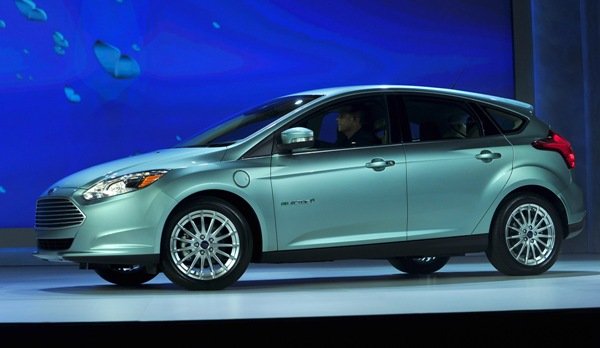First part in a series on the state of electric cars for American consumers
Ford’s electric future
Last week, Ford introduced their Ford Focus Electric in Las Vegas at the International Consumer Electronics Show (CES). Naturally, they will have the car at the North American International Auto Show in Detroit this week as well. Based on the upcoming 2012 Ford Focus, the Electric is not an all new platform, but an existing platform launched at the Paris Motor Show last year and tweaked to accommodate the electric drive train. Ford chose to partner with an outside supplier (Magna International) to provide the powertrain and battery for the car. Ford chose this route to save time and development expense.
If you have been following the LEAF for any length of time, you will find much that is similar in the Focus Electric. There is an electric motor powering the front wheels through a single-speed reduction gear transmission. Ford has released no information regarding power or torque, but they have stated that the Focus Electric has a top speed of 84 miles per hour. Many may quibble with whether this is fast enough or not, but the fact of the matter is this: 84 mph is faster than any legally posted freeway speed in the U.S. One item of note – Ford has claimed a recharge time of the 23 kilowatt hour Lithium-ion (Li-ion) battery in three to four hours using a 240 volt charging dock. Focus Electric offers a 6.6 kilowatt on-board charger vs. the 3.3 kilowatt charger used by the LEAF. While many have said that the 3.3 kilowatt charger in the LEAF should be doubled, if you plug your car in at night it will be fully charged by morning. We don’t see being charged by midnight (if plugged in at 9 PM) as any real advantage. Ford has partnered with Best Buy to sell and install charging stations for the Focus for $1,499. Ford has provided little in the way of other specifications, and nothing regarding price. Focus Electric will launch in “late 2011″ in the U.S. and Ford has not stated any production targets.
So what other plans does Ford have in the electric car arena? Nothing regarding electric cars. They have two more hybrids in the works, along with a new plug-in hybrid, but no additional electric cars. In late 2010 they completed the first Transit Connect Electric (TCE) vans. So let’s take a closer look at those. The TCE is, again, based on an existing platform. The Transit Connect is built in Turkey, has a 2.0 liter 4-cylinder engine and is front-wheel drive. It is presented as a small, light-commercial vehicle for route deliveries and similar uses. For the TCE, a glider (body less powertrain) is built in Turkey and shipped to the U.S. for final assembly. The powertrain is purchased from Azure Dynamics and installed by AM General in Michigan. The batteries are acquired from Johnson Controls-Saft. So the TCE is even more of a kit van than a production vehicle than the Focus is, with the low build rate (600 to 700 per year) that would go along with that assessment. In contrast, the Nissan NV200 received the International Van of the Year in December 2009 with plans to make an electric version of it using Nissan’s own EV technology.
It seems that Ford has acknowledged the need to offer electric vehicles to their customers as a publicity gesture, but does not feel that a commitment of their own research and development team toward this effort is worthwhile. As the only domestic manufacturer to weather the automotive fiasco in reasonably good shape, we feel that Ford’s lack of commitment in this area places them a step or two behind Chevrolet – who has developed the Volt in-house.


Pingback: Bill Ford speaks out on EV future — Living LEAF